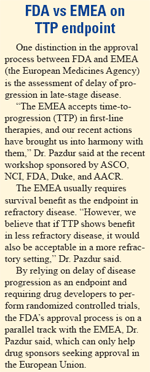Cancer drug pipeline is healthy, says head of oncologic drug approval for FDA
The US Food and Drug Administration is often depicted as an obstructionist bureaucracy that inhibits the development of life-saving cancer drugs. But according to an FDA insider, the real story on drug approval has remained untold.
ABSTRACT: Since its establishment in 2005, the Office of Oncology Drug Products has okayed 53 new indications, for an 88% approval rate.

BETHESDA, Maryland-The US Food and Drug Administration is often depicted as an obstructionist bureaucracy that inhibits the development of life-saving cancer drugs. But according to an FDA insider, the real story on drug approval has remained untold.
The agency’s drug approval process is working as intended, greenlighting a steadily increasing number of safe and effective new cancer therapies, said Richard Pazdur, MD, director of FDA’s Office of Oncology Drug Products.
“The public doesn’t hear the real story of drug approval. The press tends to focus on products we take to the Oncologic Drugs Advisory Committee, which are often problematic,” Dr. Pazdur said at a 2008 workshop, “Accelerating Anticancer Agent Development and Validation.”
“Oncology is a very active area,” Dr. Pazdur added. He noted that Investigational New Drug (IND) applications have gone up dramatically, rising from 925 in fiscal year 2003 to more than 1,400 in FY 2008.
Moreover, he said, “industry requests for critical development milestone meetings for products well past the initial IND phase have increased by 245% since 2003.This figure is almost double that of the next highest therapeutic class, endocrinology.”
This level of activity in INDs ultimately translates into applications (New Drug Applications and

Biologic License Applications) handled by Dr. Pazdur’s team, which consists of 120 physicians, scientists, and regulatory experts with special training in oncology, hematology, radiology, internal medicine, pharmacology, toxicology, regulatory review, and clinical pharmacology.
Since its establishment in 2005, the Office of Oncology Drug Products has okayed 53 new indications, for an 88% approval rate. “Of the 53 approvals, 18 were new molecular entities; 35 were supplemental indications,” Dr. Pazdur said. In the same time period, he noted, 5 drugs were not approved and 2 were withdrawn prior to a regulatory decision.
Changing endpoints
Critics have accused FDA of slowing drug approvals by its reluctance to accept surrogate endpoints of benefit other than overall survival. Dr. Pazdur stressed, however, that in recent years his office “has been increasingly willing to approve cancer drugs based on metrics of delay in disease progression.”
Although delay in disease progression is usually considered a poor surrogate for clinical benefit, the oncology drug agency has begun to recognize its benefit, especially with the arrival of new targeted therapies.
In fact, the most frequently employed endpoint for approval of oncologic drugs (from July 2005 to December 2007) was response rate (17 indications), followed by progression-free survival or time to progression (12), overall survival (10), and disease-free survival (5), he said. “We also used several novel endpoints, including reduction in hepatic iron and depletion of key enzymes,” Dr. Pazdur said.
Four of the five drugs that did not gain approval failed to achieve the primary endpoint of the pivotal regulatory trial. “An additional problem is the failure of sponsors to incorporate the agency’s advice on acceptable endpoints,” he said.
Responding to claims that the agency is granting a decreasing number of accelerated approvals, Dr. Pazdur explained that some of the endpoints previously used for accelerated approval are now considered as part of the regular approval process.
Changing the treatment landscape
Based on his office’s approval history, oncologists have even more treatment choices in relatively rare cancers, including new agents for relapsed/refractory pediatric Ph+ ALL, cutaneous T-cell lymphoma, and mantle cell lymphoma, Dr. Pazdur said.
“Behind the approval numbers are stories of changing paradigms of disease treatment,” he said. “For example, in multiple myeloma, renal cell carcinoma, and chronic myelogenous leukemia, multiple drugs have been approved over the last several years. These drugs have changed the treatment landscape for these diseases.”
Newsletter
Stay up to date on recent advances in the multidisciplinary approach to cancer.
Oncology Peer Review On-The-Go: Cancer Care Management During the COVID-19 Pandemic
October 28th 2020The newest episode of Oncology Peer Review On-The-Go speaks with 2 authors of an article from the October Issue of the journal ONCOLOGY focusing on effective cancer care management during the coronavirus pandemic.